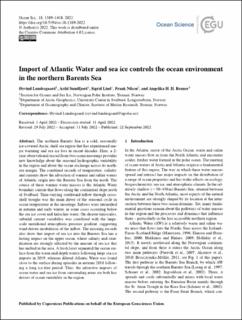| dc.contributor.author | Lundesgaard, Øyvind | |
| dc.contributor.author | Sundfjord, Arild | |
| dc.contributor.author | Lind, Sigrid | |
| dc.contributor.author | Nilsen, Frank | |
| dc.contributor.author | Renner, Angelika | |
| dc.date.accessioned | 2022-12-01T12:39:23Z | |
| dc.date.available | 2022-12-01T12:39:23Z | |
| dc.date.created | 2022-11-03T15:40:34Z | |
| dc.date.issued | 2022 | |
| dc.identifier.citation | Ocean Science. 2022, 18 (5), 1389-1418. | |
| dc.identifier.issn | 1812-0784 | |
| dc.identifier.uri | https://hdl.handle.net/11250/3035366 | |
| dc.description.abstract | The northern Barents Sea is a cold, seasonally ice-covered Arctic shelf sea region that has experienced major warming and sea ice loss in recent decades. Here, a 2-year observational record from two ocean moorings provides new knowledge about the seasonal hydrographic variability in the region and about the ocean exchange across its northern margin. The combined records of temperature, salinity, and currents show the advection of warmer and saltier waters of Atlantic origin into the Barents Sea from the north. The source of these warmer water masses is the Atlantic Water boundary current that flows along the continental slope north of Svalbard. Time-varying southward inflow through cross-shelf troughs was the main driver of the seasonal cycle in ocean temperature at the moorings. Inflows were intensified in autumn and early winter, in some cases occurring below the sea ice cover and halocline water. On shorter timescales, subtidal current variability was correlated with the large-scale meridional atmospheric pressure gradient, suggesting wind-driven modulation of the inflow. The mooring records also show that import of sea ice into the Barents Sea has a lasting impact on the upper ocean, where salinity and stratification are strongly affected by the amount of sea ice that has melted in the area. A fresh layer separated the ocean surface from the warm mid-depth waters following large sea ice imports in 2019, whereas diluted Atlantic Water was found close to the surface during episodes in autumn 2018 following a long ice-free period. Thus, the advective imports of ocean water and sea ice from surrounding areas are both key drivers of ocean variability in the region. | |
| dc.language.iso | eng | |
| dc.title | Import of Atlantic Water and sea ice controls the ocean environment in the northern Barents Sea | |
| dc.title.alternative | Import of Atlantic Water and sea ice controls the ocean environment in the northern Barents Sea | |
| dc.type | Peer reviewed | |
| dc.type | Journal article | |
| dc.description.version | publishedVersion | |
| dc.subject.nsi | VDP::Oseanografi: 452 | |
| dc.subject.nsi | VDP::Oceanography: 452 | |
| dc.source.pagenumber | 1389-1418 | |
| dc.source.volume | 18 | |
| dc.source.journal | Ocean Science | |
| dc.source.issue | 5 | |
| dc.identifier.doi | 10.5194/os-18-1389-2022 | |
| dc.identifier.cristin | 2068808 | |
| dc.relation.project | Norges forskningsråd: 276730 | |
| dc.relation.project | Norges forskningsråd: 269927 | |
| dc.relation.project | Framsenteret: 66050 | |
| cristin.ispublished | true | |
| cristin.fulltext | original | |
| cristin.qualitycode | 1 | |
